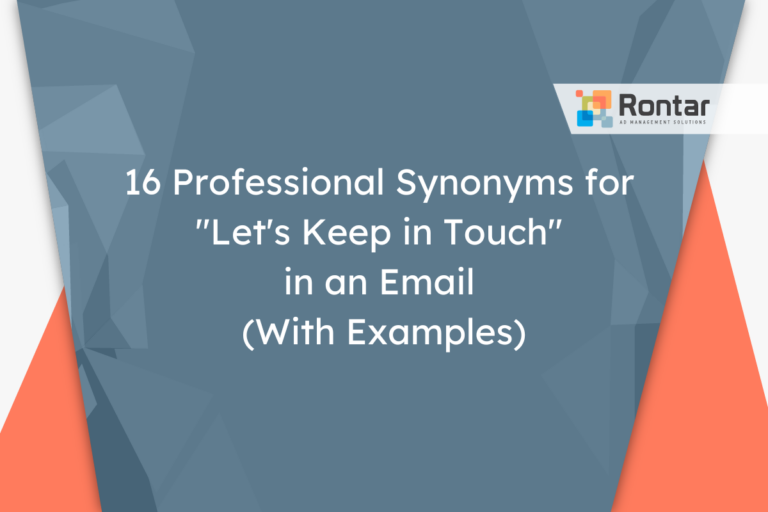Introduction The Importance of Acknowledging Emails
In today's fast-paced digital world, acknowledging the receipt of an email is crucial for effective communication. It's more than just a courtesy; it's a professional necessity that keeps the lines of communication open and ensures that messages are received, understood, and acted upon.
This article offers a comprehensive guide to 14 professional ways to acknowledge email receipt, providing you with the right language for various situations. Each option comes with explanations, ideal usage scenarios, and practical email examples to enhance your understanding and application.
1. Thank you for your email
This option is polite and formal, making it suitable for responding to emails from clients, senior colleagues, or any professional contact. It shows appreciation for the sent message and ensures the sender that their email is being taken seriously. Use it to show gratitude and a readiness to engage with the content.
Example: "Thank you for your email regarding the project proposal. I've reviewed the details and will get back to you with feedback by the end of the day."
2. I have received your email
Formal and straightforward, this is best for situations where you need to confirm receipt without providing an immediate response or action. Appropriate for peers, supervisors, or external parties when acknowledgment is necessary but a detailed reply will follow later. This assures the sender their message has not gone unnoticed.
Example: "I have received your email and will review the attached documents. I'll provide my comments by tomorrow morning."
3. Thank you
A polite acknowledgment suitable for both formal and informal settings. Best for brief replies when you want to express gratitude quickly. Works well with familiar colleagues or in less formal corporate environments. An effective way to show appreciation without making the message too lengthy.
Example: "Thank you for the update! I'll make sure to incorporate this into the presentation."
4. I’ll take a look, thanks
Strikes a balance between informal and polite, perfect for colleagues or friendly work environments. It acknowledges receipt and indicates that the sender’s request or information will be looked into shortly. Ideal when a follow-up action is required on your part.
Example: "I’ll take a look, thanks. I'll get back to you with my assessment by Friday."
5. Noted
A straightforward, somewhat informal acknowledgment. Best for team interactions or with colleagues you have a casual relationship with. Use it where brevity is appreciated and where the sender knows you well enough to understand the tone is not dismissive.
Example: "Noted. I'll schedule the meeting for next week."
6. Understood
Primarily used in informal settings, conveying a clear acknowledgment of the email’s content without much formality. Suitable for quick exchanges with team members or responding to instructions from superiors. This communicates that the message is clear and no further explanation is needed.
Example: "Understood. I'll complete the task by the end of the day."
7. Received
A very informal one-word acknowledgment, reserved for communications where brevity is critical, and the relationship permits succinctness. Effectively used within internal team communications or for quick, informal updates. Be cautious in more formal or sensitive correspondence.
Example: "Received."
8. Your email was well received
More formal and detailed, suitable for professional settings where you want to convey a thorough acknowledgment. Particularly useful with new clients, external partners, or anyone with whom you’re establishing a rapport. The addition of "well" adds a polite touch, suggesting appreciation for the content.
Example: "Your email was well received. Thank you for providing this information."
“Effective email acknowledgment is the cornerstone of clear, professional communication.
Best Practices Expert
Interactive Resources
Enhance your communication skills
Email Templates
Download pre-written email templates for various situations.
Communication Quiz
Test your knowledge of professional email etiquette.
9. Email received
Simpler and slightly less formal than the previous option, “Email received” is straightforward and appropriate in most professional exchanges. It strikes a good balance between acknowledgment and formality, making it versatile for internal team communications and emails with clients. A polished way of confirming you've seen their message without detail.
Example: "Email received. I will follow up on this matter shortly."
10. Well received
Polite and formal, suitable for interactions where more formality is needed. Great for confirming receipt to new clients, senior management, or external contacts. The term "well" suggests you value the information.
Example: "Well received. We appreciate the detailed proposal."
11. Got it
Very informal, for people you have a casual relationship with. Perfect for quick replies among team members or colleagues you interact with regularly. Ensure its informality isn’t misinterpreted as unprofessionalism or disinterest.
Example: "Got it. I'll handle this task."
12. Acknowledged
Adaptable to a variety of situations, with a formal and informal tone. Short and suggests the message was received and its content noted. Suitable for peer communications and upward reporting, particularly when the conversation thread is technical or based on task completion.
Example: "Acknowledged. The changes will be implemented by Friday."
13. Copy that
Quite informal with a casual, almost conversational feel. Mainly used in quick exchanges where both parties are comfortable with each other, often in team environments. This communicates that you have received and understand the message clearly, but is best avoided in formal communications.
Example: "Copy that. I'll update the document accordingly."
14. Well noted
Formal, conveying that you received the message and give it importance. Appropriate for correspondences requiring a detailed follow-up or when dealing with external or senior contacts. "Well noted" indicates that the email content has been received with the attention it merits.
Example: "Well noted. We will discuss these points further in our next meeting."
Final Thoughts Choosing the Right Acknowledgment
Choosing the right way to acknowledge an email can significantly impact communication. Match the tone to the situation and the person you're emailing. Use these 14 options as a guide to ensure your email responses are always on point, keeping interactions smooth and professional.